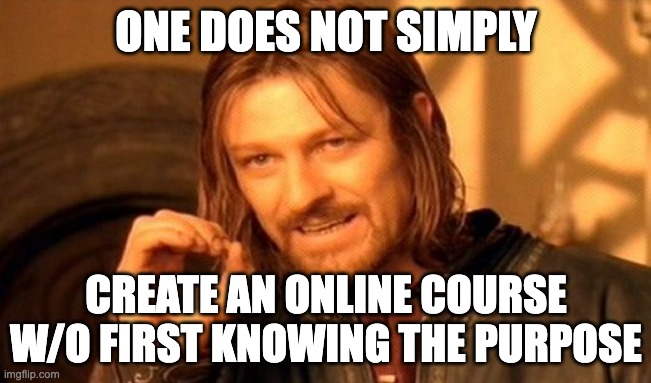Whether you’re an expert wanting to share your skills or a business wanting to train employees, online courses are a flexible and scalable way to teach.
But… creating a course isn’t just about recording a few videos and calling it a day. There’s a lot that goes into it and yes, that includes money.
Knowing the costs upfront is super important. It helps you plan better, avoid nasty surprises and ultimately create an online course that’s both high-quality and profitable.
After reading this blog post, you’ll have a rough estimate of how much it costs to create an online course.
If you’re short on time, here’s the online course pricing template.
Your Purpose (The Most Important)

Before we talk dollars and cents, let’s talk about why you’re creating the course in the first place.
Ask yourself: What do I want to achieve with this course?
Maybe you want to:
Share your expertise with the world
Create a new income stream
Better train your teammates
Build your brand as an industry leader
Whatever your goal, make it specific.
E.g. Instead of just saying “I want to make money”, say “I want to generate $1,000 in course sales within the first 6 months.”
Next, think about who you’re creating this training course for. Are they complete beginners or advanced learners? What problems are they trying to solve? Knowing your audience helps you create content that really resonates.
Finally, think about the results you want your students to achieve. Maybe it’s learning a new skill, improving productivity or solving a specific problem. Having clear outcomes in mind will help you design a course that delivers real value.
Average Cost Range and Breakdown

Now let’s talk money. How much does it actually cost to create an online course? The short answer is: it varies. A lot.
On the low end you might spend as little as $200 if you’re doing everything yourself and using basic tools. On the high end especially for complex courses or if you’re hiring professionals, costs can go up to $10,000+.
Why such a big range? It all depends on:
The length and complexity of your course
The production quality you want
Whether you’re doing it yourself or hiring help
The tools and platforms you’re using
Let’s break down the main cost categories:
A/ Content Creation
This is often the biggest chunk of your budget. It includes:
Writing scripts or course materials
Recording and editing videos
Creating graphics and visual aids
If you DIY, you only need to invest your time.
But if you outsource, especially to pros, it can get expensive fast.
It’s not uncommon for a professional scriptwriter to cost between $50-$150 per hour. Video editors? They can cost $25-$200 per hour, depending on the complexity of the task and their experience + skill.
B/ Equipment & Software
You’ll also need to invest in some gear (unless you already have them):
A quality microphone ($50-$200)
A video recording camera ($200-$1,000)
Lighting equipment ($100-$500)
For software (most offer a limited, free version):
Video editing app ($0-$100/month)
Screen recording software ($0-$50/month)
Graphic design tools ($0-$50/month)
C/ Platform & Hosting
You’ll need “a place” where students can login and access your course. This is usually done using a Learning Management System (LMS).
Basic plans on platforms like Teachable or Thinkific start at $49-$59/month
More advanced platforms like Kajabi can cost $69-$399/month
Enterprise-level solutions can run into thousands per month
If your needs are simple and you only need to provide a download area for your PDFs / files though, CartMango can be a good fit. It’s also free to use at this time.
D/ Marketing & Promotion
Forget about selling your courses if you don’t actively do marketing.
Some typical marketing costs:
Advertising on social media or Google ($100-$1000+ per month)
An email marketing tool like BirdSend ($9 per month, depending on number of subscribers)
Content marketing (blog posts, social media content)
Keep in mind the above numbers are just estimates. Actual costs will vary depending on your needs/wants.
The 3-Stage Plan for Your Course Creation & Promotion
Creating an online course isn’t only about taking out your fancy camera and then shooting some videos. It’s a process that needs careful, diligent planning.
Stage #1: Plan
The famous saying: “If you fail to plan, you plan to fail” is absolutely true. In this planning phase, you:
Research your topic and audience
Outline your course structure
Plan your content
Costs:
Your time (or a consultant’s time if you’re outsourcing)
Market research tools ($0-$100 per month)
Project management software ($0-$25 per month)
Stage #2: Create
This is the meat when creating your online course. It’s where you actually create your content and decide how to present it.
What’s involved:
Writing scripts or course materials
Recording videos
Creating quizzes or assignments
Designing slides or other visual aids
Costs:
Content creation ($0 if DIY, $500-$3,000+ depending on their skill level and/or experience)
Graphic design ($0 if DIY, $500-$2,000 for professional help)
Video production ($0 if DIY, $1,000-$10,000+ when you outsource)
Stage #3: Set Up & Launch
In this phase, you:
Set up your course on your chosen Learning Management System (LMS)
Test everything to make sure there’s no error
Prepare launch materials (emails, social media posts, ad creatives, etc.)
Costs:
LMS ($50 – $200/month)
Quality assurance (testing) ($0 if DIY, $100 – $500+ depending on how detailed you want)
Marketing materials for launch ($0 if DIY, $100-$1,000 depending on how serious you are)
DIY or Professional Help
One big decision you’ll need to make is whether to create your course yourself or hire professionals to help. Let’s weigh the pros and cons:
DIY
Pros:
Lower cost
Complete control over the process
Opportunity to learn new skills
Cons:
Time-consuming
Steeper learning curve
Potentially lower production quality
Professional Help
Pros:
Higher production quality
Faster turnaround
Feedback and ideas from experienced experts
Cons:
More expensive
Less control
Might lead to communication issues (any time you outsource there’s a possibility of miscommunication)
So, when should you outsource?
When:
You have more money than time
You want a polished course that looks good on the outside
You don’t have complete expertise in the topic of your course
Keep this in mind though: It doesn’t have to all or nothing. You could DIY on areas that you like, and outsource those that you don’t like.
Choosing the Right Tools for Online Course Development

The tools you use can play a huge part in determining how much it costs to create your course. Tools like:
Learning Management System (LMS)
This is where you’ll host your course. We’ve already covered some of them above:
Teachable: Great for beginners, starts at 59/month
Thinkific: Offers a free plan to start, paid plans from $49/month
Kajabi: All-in-one platform, starts at $69/month
LearnWorlds: Focuses on interactivity, starts at $29/month
When choosing an LMS, consider:
Ease of use: How tech-savvy are you?
Features: What do you need? (Quizzes, certificates, etc.)
Pricing: What can you afford?
Support: What kind of help is available if you get stuck?
Video Recording & Editing
Cameras: Your smartphone might be enough to start, or invest in a DSLR ($500-$1000)
Microphones: A good USB mic like the Blue Yeti ($130) can make a big difference
Screen recording: OBS Studio (free) or Camtasia ($250)
Video editing: iMovie (free for Mac), DaVinci Resolve (free), or Adobe Premiere Pro ($21/month)
Design
Canva: Great for beginners, offers a free plan
Adobe Creative Suite: More advanced
Snapseed: Free mobile app for quick edits
Project Management
Trello: Free, great for visual organization
Asana: Free for basic use, paid plans start at $10.99/user/month
Notion: Free for personal use, team plans start at $8/user/month
You don’t need to buy everything at once. Start with the essentials and upgrade as you go along.
Boosting Your Online Course with AI Tools

Artificial Intelligence isn’t just for sci-fi movies anymore. It’s making its way into online course creation and can save you time and money. Here’s how:
Content Creation
AI writing tools can help generate ideas
Tools like Jasper.ai (starts at $29/month) can help with writing course descriptions or marketing copy
Video Production
AI video editors like Runway ($15/month) can help with tasks like removing backgrounds or upscaling video quality
Text-to-speech tools can create voiceovers, save you recording time
Personalization
AI-powered LMS features can track student progress and suggest personalized learning paths
Chatbots can provide 24/7 support to students, answer common questions
Assessment / Quiz to test students’ knowledge
Use AI to come up with quizzes based on your course content
Some advanced tools can even grade open-ended answers
Remember though that AI tools are just that — tools. The definitely save you time and energy, but they’re not magic. You should always review their output to make sure everything’s in order and meet your standards.
Hidden Costs

Many folks skip this part — not sure if it’s because it’s too taboo or because they just totally forgot about it. But there are “hidden” costs to take into account. Free isn’t really free.
Time Investment
This is probably the biggest hidden cost. Creating a course takes time – often more than you expect. Consider:
Research and planning time
Content creation time
Time spent learning new tools or skills
Time spent on revisions and improvements
You won’t be paying for this time directly, but it’s time you could be spending on other projects or activities. Try to estimate how many hours you’ll spend and put a value on your time.
Ongoing Maintenance & Updates
Your course isn’t done once it launches. You’ll need to:
Keep content up-to-date
Fix any technical issues that arise
Respond to student feedback and make improvements
Budget time and possibly money for these ongoing tasks.
Customer Support
Once students start taking your course, they’ll have questions. You’ll need to factor in time for:
Answering emails
Moderating the discussion forum (if any)
Providing feedback on assignments
If your course grows, you might need to hire help for this.
Software Subscriptions
Many tools charge monthly or annual fees. These can add up over time. Consider:
LMS fees
Video hosting fees
Design tool subscriptions
Make sure to factor these ongoing costs into your budget.
Marketing Costs
Getting your course in front of potential students isn’t free. You might need to budget for:
Paid advertising
Content marketing (blog posts, social media content)
Email list building
Legal & Administrative Costs
Depending on your situation, you might need to consider:
Business registration fees
Taxes on course income
Legal fees for terms of service or copyright protection
By keeping these hidden costs in mind, you can create a more accurate budget and avoid surprises down the road.
Pricing Strategy

Now that we’ve talked about how much it costs to create a course, let’s flip the script and talk about how much you should charge for it.
Pricing your course right is important – too high and you might scare away potential student / customers; too low and you might not cover your costs or reflect the true value of your course (low perceived value).
Consider These Factors
Your costs: At least you want to cover what you spent on the course.
Time investment: Don’t forget to factor in the value of your time.
Market rates: Look at similar courses in your niche. Where do you fit in?
Your brand and expertise: If you’re a well-known expert, you can charge more.
Course length and depth: Generally, more in-depth courses can command higher prices.
Target audience: What can your ideal student afford?
Value provided: What results can students expect? How will the course impact their lives or careers?
Online Course Pricing Strategies
Cost-plus pricing: Add up your costs, add your desired profit margin, and there’s your price.
Value-based pricing: Base your price on the value students will get from the course.
Competitive pricing: Set your price in relation to similar courses in the market.
Tiered pricing: Offer different levels (e.g., basic, premium, VIP) at different price points.
Using a Pricing Calculator
There are online tools that can help you determine a profitable price. They typically factor in:
Your course creation costs
Desired profit margin
Estimated number of sales
While these can be helpful, remember they’re just a starting point. You’ll need to adjust based on your specific situation and market.
ROI Considerations
Think about the return on investment (ROI) – both for you and your students.
For you:
How many courses do you need to sell to break even?
What’s your profit per sale?
How long will it take to recoup your investment?
For your students:
What value will they get from the course?
How does the course price compare to this value?
Can you quantify the benefits (e.g., potential salary increase, time saved)?
Use the above as GUIDELINES to price your course, not as mantras. The pricing isn’t set in stone. Many course creators I know start with a lower price point to gain traction and reputation before gradually increasing their prices and making the course better over time.
Making sure your course is USEFUL
True value is not determined by how “long” or “meaty” your course is. If something can be taught in 10 minutes, why would you need a 2-hour video? People are busy and would rather spend the least amount of time going through your course.
True value is measured by how “USEFUL” your course is to them.
Here are a few ways to do just that:
Solve a Specific Problem
Focus on solving a specific problem or teaching a specific skill
Provide practical, actionable steps… not just theories
Include real-world examples and case studies for better comprehension
E.g. Instead of “How to become a master at communication”, you might create “How to talk like a pro TED speaker in 90 days.”
Create an Online Community
Set up a private Facebook group or Discord server for your students
Encourage healthy discussions & online learning
Show up and engage with the community regularly to answer questions and provide extra tips
This creates a sense of belonging and support that can be super valuable to students.
This not only creates a sense of belonging, it also presents you in a good light.
Host Q&A Sessions
Schedule regular live calls (monthly, weekly, etc.) to answer any questions & provide extra tips
You can also bring in guest experts that don’t overlap with your expertise
Live interaction with you is a personal touch that many students love.
Provide Downloadable Resources
Create worksheets that help students apply what they’ve learned
Offer templates that students can use in their own work
Include checklists to help students track their progress
These resources help students take action on what they’re learning, so the course is more practical.
Offer Personalized Feedback
Feedback on assignments or projects
One-on-one coaching sessions (perhaps as a premium add-on)
AI tools to provide automated personalized feedback on quizzes or assignments
Personal feedback can add a lot of value to your course.
Keep Your Content Fresh
Review and update your course content regularly
Add new lessons or modules as your industry changes
Promote these updates to show your course is current
Being current shows you’re committed to ongoing value for your students.
Offer Certificates of Completion
A professional-looking certificate when students complete the course
Make sure the certificate includes course name, date and your signature
Consider getting your course accredited if applicable in your industry
Certificates provide proof of learning or e-learning which many students value. Some jobs might require people to show their certificates – so this will be helpful to them too.
Launching & Marketing Online Courses
Creating a great course is only half the battle. To make it successful you need to get it in front of the right people. Here’s how to launch and market your online course:
Build Hype
Tease Your Course: Start talking about your course on social media, your blog or your email list well before the launch.
Offer Pre-Launch Content: Share some of your course content or create a free mini-course to give people a sneak peek.
Create a Waiting List: Allow people to sign up for launch notifications. This creates a sense of scarcity.
Launch Plan
Choose a Launch Model: Open/closed launch (enrollment only available for a limited time) or evergreen (always open for enrollment)
Launch Timeline: Create a schedule for your launch, including when you’ll start promotions, when enrollment opens and any special offers.
Launch Materials: Create sales pages, email sequences, social media posts etc.
Use Multiple Marketing Channels
Email Marketing: If you have an email list this should be your main focus. Send a sequence of emails before and during your launch.
Social Media: Use your socials to create buzz. Consider using live videos or stories to give a sneak peek into your course.
Content Marketing: Write blog posts or create videos around your course topic to attract interested students.
Paid Ads: If you have the budget, paying for Facebook Ads and Google Adwords can help you reach a bigger audience.
Affiliate Marketing: Who has your audience? You can offer them a commission in exchange for them promoting your course to their audience.
Launch Specials
Early Bird Discount: Offer discounts for folks who enroll early. These are “early adopters” and should be rewarded accordingly.
Bonuses: 1:1 coaching sessions, access to a private community, or extra templates and tools for launch period only.
Payment Plans: Increase sign-ups by making your course more affordable. Payment plans aren’t restricted for physical goods only.
Nurturing Your Audience
Webinar: Host a free training program around your course topic… making sure to cover the what, why, and a bit of the how. Then pitch your course at the end.
Q&A Sessions: Host live Q&A’s to answer any questions potential students may have. The more thorough your answers are, the higher the chance people sign up.
Reply to questions and comments: Make sure to check your social media and email inbox to answer questions and address feedback.
Measure / Track
Sales: Note down your your enrollment numbers throughout the launch.
Marketing: Use data to determine which marketing channel(s) drive the mort sales. Do more of these.
Feedback: The market (your audience) is the most important factor. Ask early students why they signed up for your course.
After the Launch
Get the truth on the table: Most people won’t buy and that’s normal in any industry or market. But them not buying during the launch period doesn’t mean they won’t buy in the future. Ask them why they didn’t buy this time around. We want to get “the truth on the table”. We don’t want fake answers. So encourage them to be honest in their response. Assure them you won’t be offended.
Improve: By getting the real reasons why people don’t buy, you can improve your offer, messaging, and positioning to get better results the next time you re-open your course.
Social proof: Share your launch results with your audience to build credibility and authority. They might want to get your course the next time it opens.
Remember launching and marketing your course is an ongoing process. Be prepared to adjust your strategy as you go based on what works for your audience and your course. With consistency and the right approach you can get your course in front of the people who need it most.
Cost Saving Tips

You don’t have to break the bank to create an online course. Here are some ways to save your course development costs without sacrificing quality:
Free & Low Cost Tools
Free LMS Platforms: Use free plans to test your course idea before moving to paid plans.
Open-Source Software: Use free, open-source video editing software (OpenShot), graphic design software (GIMP) and audio editing software (Audacity).
Free Stock Resources: Use free stock photo and video sites like Pexels, Unsplash and Pixabay for course visuals.
DIY Where Possible
Record Yourself: With a smartphone and good lighting you can create decent quality videos without professional equipment.
Create Your Own Graphics: Use user-friendly tools like Canva to create course materials and promotional content.
Write Your Own Content: Use your expertise without hiring writers.
Gradual Scaling
Start small with a low price point: Start with a mini-course or a series of workshops to test your idea before investing in a full course.
Reinvest Profits: Use the profits from your initial launches to fund improvements and expansions.
Upgrade incrementally to eventually reach premium pricing: Start with basic tools and upgrade to more advanced options as your course grows and generates revenue.
Real Examples
Let’s take a look at some real life examples of course creation costs and results:
Case Study #1: Pat Flynn’s “Power-Up Podcasting”
Pat Flynn, a well known online entrepreneur created the “Power-Up Podcasting” course.
Price: $799
Revenue:
Over $500,000 in the first year
Students: Over 1,500 in the first year
Strategy:
Flynn used his existing audience from his blog and podcast to launch the course. He also offered a free “Podcast Cheat Sheet” as a lead magnet to build his email list specifically for this course.
Source: Smart Passive Income Blog
Case Study #2: Melyssa Griffin’s “Pinfinite Growth”
Melyssa Griffin, business strategist and online educator created the “Pinfinite Growth” course on Pinterest marketing.
Price: $397
Revenue: Over $1 million in year 1
Students: Over 2,500 in year 1
Strategy:
She ran webinars that educate people about the importance of using Pinterest for their marketing. She provided upfront value, then at the end of the webinars she pitched her course.
Source: Melyssa Griffin’s Blog
Case Study #3: John Lee Dumas’ “Podcasters’ Paradise”
John is host of the Entrepreneurs on Fire podcast. He created the “Podcasters’ Paradise” course on starting and growing a podcast.
Price: $997 (one-time) or $97/month
Revenue: Over $4 million
Students: Over 3,000 members
Strategy:
This is one of the best “putting your mouth where your money is” examples. How so?
1/ John is famous for his podcast
2/ His course is about using podcast to create a strong brand and following
3/ He uses his podcast to promote his “podcasting” course
Source: Entrepreneurs on Fire Income Reports
These examples show that to sell your courses successfully, you need to have a targeted audience who’s interested in your topic. There are many ways to build an audience — webinars, podcasting, ads, social media, etc.
But one thing is clear: Regardless of which channel you go for — make sure to have an email list that you can contact over and over. If they don’t buy now, you can always nurture your relationships with them so they buy in the future.
7 Steps to Answer “How Much Does It Cost to Create an Online Course”?
Step 1: Define Your Course
How many hours of content?
What type of content (video, text, quizzes etc.)?
Step 2: List The Resources Needed
What kind of equipment (camera, mic, lighting)
What type of software (video editing, graphic design, LMS)
What services will you outsource (if any)
Step 3: Research
Get quotes for the services you need
Compare prices for equipment & software
Step 4: Estimate The Time Required
How long will planning and research take?
How long will content creation take?
How long will editing take?
How long will marketing and promotion take?
Step 5: Add Up Costs
Total monetary costs
Time value (your time x hourly rate)
Step 6: Factor in Ongoing Costs
Software recurring fees
Marketing budget
Costs for keeping the course up-to-date
Step 7: Contingency
Add 10-20% for unexpected expenses that may come up
Here’s a Simple Online Course Pricing Calculator Template:
Equipment: $________
Software: $________
Services: $________
Marketing: $________
Your Time (hours * hourly rate): $________
Ongoing: $________
Subtotal: $________
Contingency (20% of subtotal): $________
Total Cost: $________Of course, this is just an estimate. Actual numbers will vary. But it’s still better than not having any estimate at all.
Summing Up

As you can see, answering the question “How much does it cost to create an online course” is no easy task.
But creating + marketing it is even harder.
You’d need to: build an audience to sell to, actually create USEFUL content that solve’s people’s problems, make the content practical and actionable, understanding marketing and copywriting, etc.
But if you ask me? The rewards are well worth it.
Takeaways:
1/ Understand your course creation goals: If something doesn’t align with your goals, don’t do it.
2/ Plan wisely: It’s not just about creating the content of the course, it’s also about marketing.
3/ Price your course wisely: Apart from factoring in hardware and software costs, remember to factor in your time too.
4/ Pick the right tools: Choose those that fit your needs and budget.
5/ Focus on making students WIN: Nothing else matters if your students don’t get good results from your course.
6/ Build it and they’ll come is BS: Even the best course needs a good promotion strategy to sell well.
7/ Adapt: Always be on the lookout to new trends and developments. Be prepared to update your course accordingly.
Remember, the most expensive course isn’t the most successful. What matters most is the value you deliver to your students. With planning, investment and focus on quality you can create a course that covers its costs and generates big profits and impact.
Whether you’re a first time online course creator or an experienced educator looking to add to your offerings, I hope this guide has been helpful in understanding the costs and considerations of creating an online course.
If you’re a solo course creator with less than 10 teammates, and you you just want a fast cart / checkout software that works, check out our very own CartMango (free to use at this time)
Frequently Asked Questions
Q: How long does it take to create an online course?
Time frame varies depending on course complexity and your time. A simple course might take 4-6 weeks, a full program several months.
Q: Can I update my course after it’s launched?
Yes. In fact you should. Most LMS platforms make it easy to update content.
Q: Is there a market for my course?
Research your niche, look at competitor courses and engage with your target audience on social media or through surveys to gauge interest in your course.
Q: Should I offer a money back guarantee for my course?
Many course creators offer money back guarantees to reduce the risk for students. But it’s a personal decision based on your confidence in your course and your target market.
Q: How do I stand out in a crowded market?
Focus on your strengths and specificity. Offer more value and consider niching down to a specific part of your broader topic.
Q: One time purchase or subscription model?
This depends on your course structure and content. One time purchases work for self-contained courses, subscription models for continuously updated content or community based programs.
Q: Is it important to have a professional looking course?
While content is king, a professional look can increase credibility and student engagement. Aim for the best you can do within your budget.
By answering these questions and following this guide you’ll be ready to dive into the world of online course creation.
Every expert was once a beginner – your knowledge and perspective have value and there are students out there who want to learn from you.
Related Reading
- Cart abandoned email templates for course creators
- How to sell online courses
- What is an online course
- What are digital products
- 100 digital marketing terms course creators should know
- 49 Key affiliate marketing stats
- 200 ideas for your online courses
- How to create an online course PDF
- Places to source digital products for reselling
- What is digital publishing
- Solopreneur coaching
